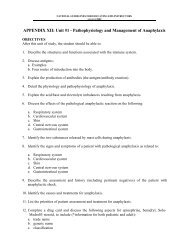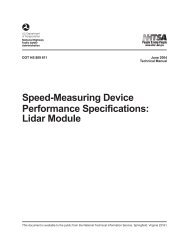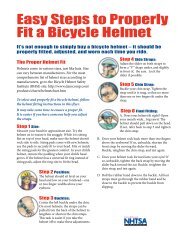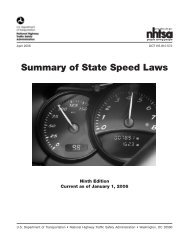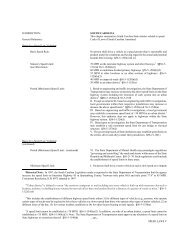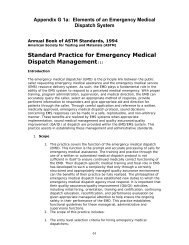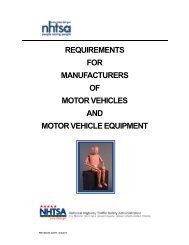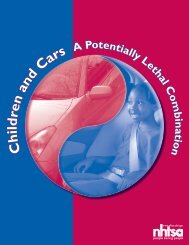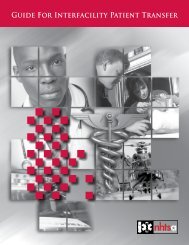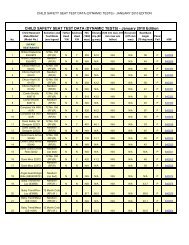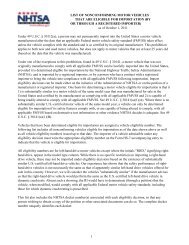The Criminal Justice System: A Guide for Law Enforcement ... - NHTSA
The Criminal Justice System: A Guide for Law Enforcement ... - NHTSA
The Criminal Justice System: A Guide for Law Enforcement ... - NHTSA
Create successful ePaper yourself
Turn your PDF publications into a flip-book with our unique Google optimized e-Paper software.
to convey this in<strong>for</strong>mation in a manner understandable to the jury is what makes the officer<br />
an “expert” witness even if not within the legal meaning of “expert witness.”<br />
DRUG EVALUATION and CLASSIFICATION TESTIMONY<br />
In many jurisdictions, the DRE (Drug Recognition Evaluator/Expert) may be put<br />
<strong>for</strong>th as a “technical” expert, one with specialized knowledge whose testimony is based<br />
on observation, education, training, skill, and experience 3 . <strong>The</strong> DRE is not a doctor,<br />
pharmacologist, or toxicologist. Nonetheless, the DRE has specialized knowledge that<br />
will assist the trier-of-fact to understand the evidence. Just as an individual does not have<br />
to understand how a television works in order to determine that the set is working, the<br />
DRE does not need to know the scientific explanation of how drugs cause impairment to<br />
recognize impairment. Prosecutors handling drug-impaired-driving cases will find DRE<br />
testimony particularly helpful. For further details, see <strong>The</strong> Drug Evaluation and<br />
Classification (DEC) Program available <strong>for</strong> downloading at www.ndaaapri.org/publications/apri/traffic_law.html.<br />
In a typical alcohol-impaired-driving case, an officer may testify to many<br />
indicators of alcohol impairment observed during the investigation. <strong>The</strong> officer’s<br />
testimony is based on observation, training, and experience in detecting impaired drivers<br />
even though the signs of impairment are based on scientific principles.<br />
A driving under the influence of drugs (DWID) case comes be<strong>for</strong>e the court in<br />
the same manner as an alcohol-impaired-driving case. <strong>The</strong> arresting officer either<br />
comes upon an incident or makes a traffic stop because there is a traffic violation or<br />
reasonable suspicion to believe that the suspect is driving under the influence of an<br />
intoxicating substance. <strong>The</strong> initial investigation is conducted as any other impaireddriving<br />
case. Observations of impairment are made by the arresting officer in the course<br />
of the investigation.<br />
<strong>The</strong> DRE usually becomes involved after the suspect takes a breath test and the<br />
results are inconsistant with the impairment the arresting officer observed. For example,<br />
the suspect was driving erratically and per<strong>for</strong>med the SFSTs poorly but the breath test<br />
result is .02 BAC. Sometimes the arresting officer may suspect drug impairment at the<br />
outset from observations of drugs or drug paraphernalia on the suspect or in the car, with<br />
or without a subsequent breath test. And, sometimes the defendant volunteers that he has<br />
consumed something other than or in addition to alcohol. That admission, without more,<br />
is generally not enough to convict <strong>for</strong> drug-impaired driving.<br />
<strong>The</strong> DRE is called in <strong>for</strong> three distinct purposes: First, the DRE establishes that<br />
the suspect’s impairment is caused by a drug or drugs other than or in addition to alcohol,<br />
and rules out a medical condition or medical emergency.<br />
3<br />
Drug Evaluation and Classification (DEC) is the State program, while a DRE is an officer that is a part of<br />
the DEC program.<br />
16



